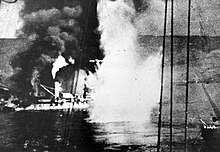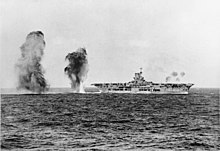James Somerville
Sir James Somerville | |
|---|---|
Eastern Fleet (1942–44) (1922–23)Force H (1940–42) Battlecruiser Squadron (1940) East Indies Station (1938–39) Destroyer Flotillas, Mediterranean Fleet (1936–38) HMS Norfolk (1931–32) HMS Barham (1927–29) HMS Warspite (1927) HMS Benbow | |
| Battles/wars |
|
| Awards | Commander of the Legion of Merit (United States) |
Somerville later became
Early life and family
Somerville was born on 17 July 1882, the second son of Arthur Fownes Somerville, of
In 1913, Somerville married Mary Main; they had a daughter and a son.[5] His son Lieutenant-Commander John Arthur Fownes Somerville, CB, CBE served in the Royal Navy and became the deputy director of GCHQ.[6] The news reader Julia Somerville is one of their granddaughters.[7]
Early career
Somerville joined the training ship
Somerville served in the Royal Navy in the
Somerville stayed in the service after the war, becoming Executive Officer in the battleship
Somerville became Flag Officer Destroyers in the Mediterranean Fleet in March 1936 and during the
European operations, 1939–1942


With the approach of the
You are charged with one of the most disagreeable tasks that a British Admiral has ever been faced with, but we have complete confidence in you and rely on you to carry it out relentlessly.[18]
Although Somerville privately felt that such an attack would be a mistake, he carried out his orders. The French refused to comply with British conditions and so on 3 July 1940, Force H attacked French ships at Mers-el-Kébir. Somerville's forces inflicted severe damage on their erstwhile allies, most notably sinking the battleship Bretagne with heavy loss of life. Several other major French ships were damaged during the bombardment. The operation was judged a success, but he admitted privately to his wife that he had not been quite as aggressive in the destruction as he could have been.[19] He was Mentioned in Despatches on 16 August 1940.[20]
Somerville transferred his flag to the battlecruiser HMS Renown in August 1940 and led the British forces in the Battle of Cape Spartivento in November; Churchill was outraged at Somerville for not continuing the pursuit of the Italian Navy after that battle and dispatched the Earl of Cork to conduct an inquiry, but Cork found that Somerville had acted entirely appropriately.[21] Force H bombarded Genoa on 9 February 1941, and Somerville, still in HMS Renown in May 1941, also played an important role in the pursuit and sinking of the German battleship Bismarck later that month.[21] Somerville transferred his flag to the battleship HMS Nelson in August 1941 and also played a major role in protecting Malta from enemy attack in autumn 1941.[22] He transferred his flag to the battleship HMS Rodney and then to the battleship HMS Malaya.[21] He was appointed a Knight Commander of the Order of the British Empire for his service with Force H on 21 October 1941.[23]
Indian Ocean, 1942–1944

Somerville became
For most of the rest of 1942, Somerville's fleet avoided any major operations against the Japanese, barring a brief sortie into the Bay of Bengal in late July and early August 1942 during which he turned back after being spotted by a Japanese flying boat on 2 August 1942. Somerville's unwillingness to risk his ships in a diversionary attack against the Japanese in Southeast Asia during mid- and late 1942, which he saw as necessary to preserve its precariously limited strength and its ability to guard merchant convoys in the Indian Ocean, was met with derision by US Chief of Naval Operations Admiral Ernest J. King, as King believed that the Eastern Fleet doing so would greatly assist the Americans in their own operations against the Japanese as they clashed at the Battles of the Coral Sea and Midway and throughout the Guadalcanal campaign.[26]
In Spring 1944, with reinforcements, Somerville was able to go on the offensive in a series of aggressive air strikes in the Japanese-occupied
Later career
Somerville was placed in charge of the British naval delegation in
Later life
In retirement Somerville became
Citations
- ^ Fox-Davies (1905), p. 1203; Venn (1953), p. 159 for her father's full name.
- ^ Venn (1953), p. 591
- ^ According to Venn (1953), p. 591, Arthur Fownes Somerville was the son of James Curtis né Fownes (later Somerville); born in 1807, he was the son of James Somerville né Fownes (later Somerville), JP (see Venn (1944)); Burke (1847), p. 1262, then states that this James Somerville Somerville was the son of the Rev. Thomas Fownes, son of John Fownes, MP for Dartmouth from 1715 to 1722, who was son of John Fownes, MP for the same from 1714 to 1715. Burke, ibid., also states that the Rev. Thomas married a daughter and heiress of the Hon. George Somerville of Dinder House, and describes the inheritance of that estate as well as the name change.
- ^ Simpson (2004) ; Venn (1953), p. 159 gives his mother as Emily Piriam Hood, daughter of Sir Alexander Hood, Baronet. He was the second Baronet and his family is outlined in Burke (1865), pp. 583–584, which also refers to the connection with the Viscounts Hood.
- ^ a b c d e f g Heathcote, p. 231
- ^ "John Somerville". The Times. 1 December 2005.
- ^ Morris, p. 33
- ^ "No. 27549". The London Gazette. 5 May 1903. p. 2841.
- ^ "No. 27659". The London Gazette (Supplement). 18 March 1904. p. 1791.
- ^ "No. 29423". The London Gazette (Supplement). 31 December 1915. p. 90.
- ^ "No. 29507". The London Gazette (Supplement). 14 March 1916. p. 2872.
- ^ "No. 29507". The London Gazette (Supplement). 14 March 1916. p. 2869.
- ^ a b c d e f g h i Heathcote, p. 232
- ^ "No. 32563". The London Gazette (Supplement). 30 December 1921. p. 10719.
- ^ "No. 34119". The London Gazette (Supplement). 28 December 1934. p. 3.
- ^ a b "Admiral Sir James Somerville, 1882–1949". History of War. Retrieved 31 August 2014.
- ^ "No. 34633". The London Gazette (Supplement). 6 June 1939. p. 3853.
- ^ Holland, p. 454
- ^ "Mers-el-Kebir: A Battle Between Friends". Military History Online. Retrieved 31 August 2014.
- ^ "No. 34925". The London Gazette. 16 August 1940. p. 5068.
- ^ a b c d e f Heathcote, p. 233
- ^ required.)
- ^ "No. 35317". The London Gazette (Supplement). 17 October 1941. p. 6099.
- ^ "No. 36734". The London Gazette. 6 October 1944. p. 4592.
- ^ "Leonard Birchall and the Japanese raid on Colombo". National Defence and the Canadian Armed Forces. Archived from the original on 10 August 2014. Retrieved 31 August 2014.
- ISSN 0025-3359. Retrieved 15 April 2024 – via Taylor and Francis Online.
- ^ "No. 36666". The London Gazette (Supplement). 18 August 1944. p. 3887.
- ^ "No. 36800". The London Gazette. 17 November 1944. p. 5293.
- ^ "No. 37407". The London Gazette. 28 December 1945. p. 13.
- ^ "Sir James Somerville". Unit Histories. Archived from the original on 8 April 2018. Retrieved 31 August 2014.
- ^ "No. 37842". The London Gazette. 3 January 1947. p. 122.
Cited sources
- Fox-Davies, Arthur Charles (1905). Armorial Families. London: Hurst & Blackett.
- Heathcote, Tony (2002). The British Admirals of the Fleet 1734–1995. Pen & Sword Ltd. ISBN 0-85052-835-6.
- Holland, James (2011). The Battle of Britain. Corgi. ISBN 978-0552156103.
- Morris, Oswald (2006). Huston, We Have a Problem: A Kaleidoscope of Filmmaking Memories. Rowman & Littlefield Education. ISBN 978-0810857063.
- Venn, J. A. (1944). Alumni Cantabrigienses, part ii, volume ii. University of Cambridge.
- Venn, J. A. (1953). Alumni Cantabrigienses, part ii, volume v. University of Cambridge.
Further reading
- Burke, B (1865). A Genealogical and Heraldic Dictionary of the Peerage and Baronetage of the British Empire. Harrison.
- Burke; Burke, J.B (1847). A Genealogical and Heraldic Dictionary of the Landed Gentry of Great Britain and Ireland volume ii. Henry Colburn.
- MacIntyre, Donald (1961). Fighting Admiral: The Life of Admiral of the Fleet Sir James Somerville. Evans Brothers, London.
- Somerville, James (1996). The Somerville Papers: Selections from the Private and Official Correspondence of Admiral of the Fleet Sir James Somerville, GCB, GBE, DSO. Navy Records Society, London. ISBN 978-1859282076.
External links
- A biography of Admiral Somerville (H.M.S. Hood Association web site).
- Transcription of official service record (admirals.org.uk)
- British Admiralty document on Mer-el-Kebir Action
- Transcription of Force H War Diary.
- Newsreel footage of Admiral Somerville on a destroyer, early in WW2 Archived 11 June 2011 at the Wayback Machine
- James Somerville at Unit Histories Archived 8 April 2018 at the Wayback Machine
- The Dreadnought Project: James Somerville
- The Papers of Admiral Sir James Somerville held at Churchill Archives Centre
